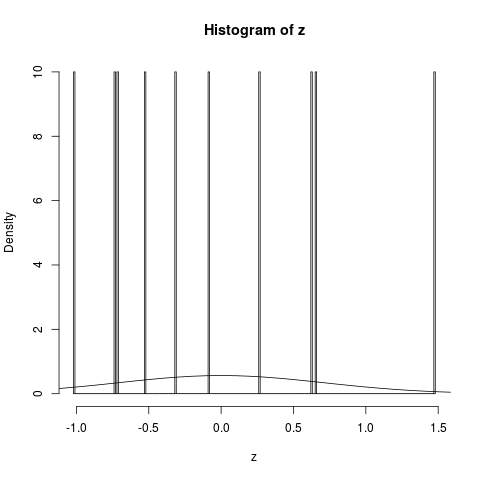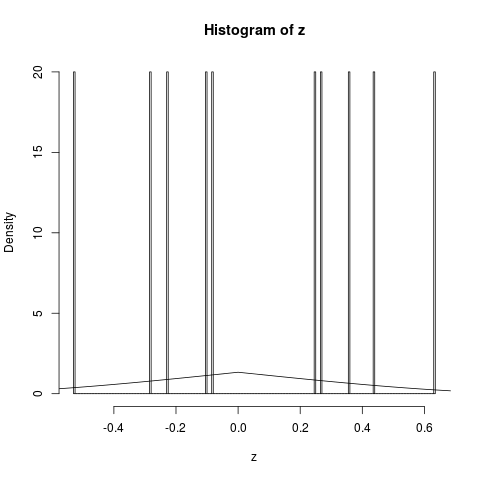Supported by Dr. Osamu Ogasawara and  providing providing  . . |
|
Last data update: 2014.03.03 |
Random scaling used with ballsDescriptionApproximates an isotropic decreasing density function by a density function that is isotropic with respect to the l_1 norm. Usage
RRrectangular(phi, safety, minsteplen, maxsteps, parts, maxit,
innermin, outermax, mcmc_n, normed, approx, onesided)
Arguments
DetailsThis models defines an isotropic density function $f$ with respect to the l_1 norm. i.e. f(x) = c φ(|x|_{l_1}) with some function φ. Here, s is norming constant so that the integral of f equals one. In case φ is monotoneously decreasing then rejection sampling is used, else MCMC. The function φ might have a polynomial pole at the origin and asymptotically decreasing of the form x^β exp(-x^δ). Value
Author(s)Martin Schlather, schlather@math.uni-mannheim.de See Also
ExamplesRFoptions(seed=0) ## *ANY* simulation will have the random seed 0; set ## RFoptions(seed=NA) to make them all random again # simulation of Gaussian variables (in a not very straight forward way): distr <- RRrectangular(RMgauss(), approx=FALSE) z <- RFrdistr(distr, n=1000000) hist(z, 200, freq=!TRUE) x <- seq(-10, 10, 0.1) lines(x, dnorm(x, sd=sqrt(0.5))) #creation of random variables whose density is proportional # to the spherical model: distr <- RRrectangular(RMspheric(), approx=FALSE) z <- RFrdistr(distr, n=1000000) hist(z, 200, freq=!TRUE) x <- seq(-10, 10, 0.01) lines(x, 4/3 * RFcov(RMspheric(), x)) Results
R version 3.3.1 (2016-06-21) -- "Bug in Your Hair"
Copyright (C) 2016 The R Foundation for Statistical Computing
Platform: x86_64-pc-linux-gnu (64-bit)
R is free software and comes with ABSOLUTELY NO WARRANTY.
You are welcome to redistribute it under certain conditions.
Type 'license()' or 'licence()' for distribution details.
R is a collaborative project with many contributors.
Type 'contributors()' for more information and
'citation()' on how to cite R or R packages in publications.
Type 'demo()' for some demos, 'help()' for on-line help, or
'help.start()' for an HTML browser interface to help.
Type 'q()' to quit R.
> library(RandomFields)
Loading required package: sp
Loading required package: RandomFieldsUtils
This is RandomFieldsUtils Version: 0.2.1
This is RandomFields Version: 3.1.16
Attaching package: 'RandomFields'
The following object is masked from 'package:RandomFieldsUtils':
RFoptions
The following objects are masked from 'package:base':
abs, acosh, asin, asinh, atan, atan2, atanh, cos, cosh, exp, expm1,
floor, gamma, lgamma, log, log1p, log2, logb, max, min, round, sin,
sinh, sqrt, tan, tanh, trunc
> png(filename="/home/ddbj/snapshot/RGM3/R_CC/result/RandomFields/RRrectangular.Rd_%03d_medium.png", width=480, height=480)
> ### Name: RRrectangular
> ### Title: Random scaling used with balls
> ### Aliases: RRrectangular
> ### Keywords: spatial models
>
> ### ** Examples
>
> RFoptions(seed=0) ## *ANY* simulation will have the random seed 0; set
> ## RFoptions(seed=NA) to make them all random again
> ## Don't show:
> StartExample()
> ## End(Don't show)
> # simulation of Gaussian variables (in a not very straight forward way):
> distr <- RRrectangular(RMgauss(), approx=FALSE)
> z <- RFrdistr(distr, n=1000000)
number of simulations reduced
> hist(z, 200, freq=!TRUE)
> x <- seq(-10, 10, 0.1)
> lines(x, dnorm(x, sd=sqrt(0.5)))
>
>
> #creation of random variables whose density is proportional
> # to the spherical model:
> distr <- RRrectangular(RMspheric(), approx=FALSE)
> z <- RFrdistr(distr, n=1000000)
number of simulations reduced
> hist(z, 200, freq=!TRUE)
> ## Don't show:
> StartExample(reduced=FALSE)
> ## End(Don't show)
> x <- seq(-10, 10, 0.01)
> lines(x, 4/3 * RFcov(RMspheric(), x))
> ## Don't show:
> FinalizeExample()
> ## End(Don't show)
>
>
>
>
>
>
> dev.off()
null device
1
>
|

